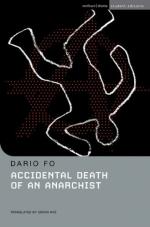|
This section contains 353 words (approx. 1 page at 400 words per page) |

|
Accidental Death of an Anarchist Summary & Study Guide Description
Accidental Death of an Anarchist Summary & Study Guide includes comprehensive information and analysis to help you understand the book. This study guide contains the following sections:
This detailed literature summary also contains Bibliography and a Free Quiz on Accidental Death of an Anarchist by Dario Fo.
Dario Fo's Accidental Death of an Anarchist (1970) responds to events unfolding in Italy in the late 1960s and early 1970s. Generally, it looks at police corruption and suspicions regarding the government's collusion in this corruption. More specifically, it addresses the actual death of an anarchist who was being held in police custody following the bombing of a Milan bank that killed sixteen people and wounded about ninety. The police asserted that the anarchist's death was a suicide, that the man threw himself from a fourth-floor window in despair at being found out for his crime. At the subsequent inquest, the presiding judge declared the death not a suicide but an accident. Most Italians believed that the death was the result of overly harsh interrogation techniques, if not a case of outright murder on the part of the interrogators.
Accidental Death of an Anarchist is mainly about police corruption, underscored by the play's focus on impersonation, infiltration, and double-talk. A fast-talking major character, the Maniac, infiltrates a police headquarters. Posing as an investigating judge, he tricks the policemen into contradicting themselves and admitting that they are part of a cover-up involving the death of an anarchist. In infiltrating police headquarters by misrepresenting himself (impersonation), the Maniac reminds audiences of how most political groups in Italy, particularly left-wing groups, were infiltrated by police agents who acted as informers. The Maniac's flip-flop of point of view and statement achieves much the same effect as his impersonations do. His confusing speechifying leads to the police contradicting themselves, so that the Maniac, in all of his deceptions and distortions, is a precise reflection of what the play is designed to expose.
Accidental Death of an Anarchist is one of Fo's most popular plays both within and outside Italy. It has played around the world over the years to millions of people, a popular choice of directors who want to point to corruption in their midst. Pluto Press (London) put out the first English version, translated by Gavin Richards. In 1992, Methuen published a fine set of volumes of Fo's plays, which included Accidental Death of an Anarchist.
Read more from the Study Guide
|
This section contains 353 words (approx. 1 page at 400 words per page) |

|



